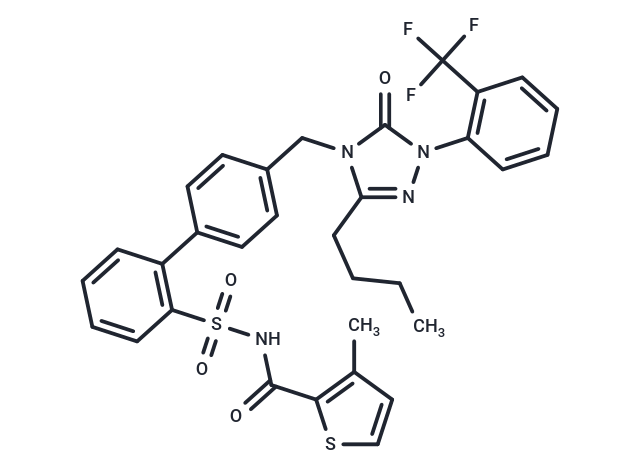Shopping Cart
Remove All Your shopping cart is currently empty
Your shopping cart is currently empty
L-161982 is a selective EP4 receptor antagonist that inhibits PGE2-induced ERK phosphorylation and cell proliferation in HCA-7 cells and alleviates collagen-induced arthritis in mice.

| Pack Size | Price | USA Warehouse | Global Warehouse | Quantity |
|---|---|---|---|---|
| 1 mg | $64 | In Stock | In Stock | |
| 5 mg | $131 | In Stock | In Stock | |
| 10 mg | $223 | In Stock | In Stock | |
| 25 mg | $471 | In Stock | In Stock | |
| 50 mg | $676 | In Stock | In Stock | |
| 100 mg | $943 | In Stock | In Stock | |
| 200 mg | $1,270 | - | In Stock | |
| 1 mL x 10 mM (in DMSO) | $189 | In Stock | In Stock |
| Description | L-161982 is a selective EP4 receptor antagonist that inhibits PGE2-induced ERK phosphorylation and cell proliferation in HCA-7 cells and alleviates collagen-induced arthritis in mice. |
| In vitro | METHODS: HCA-7 cells were pre-incubated with L-161,982 (10 μM) and then stimulated with PGE for 72 h to evaluate whether inhibition of EP4 receptors by L-161,982 inhibits cell proliferation of PGE-stimulated HCA-7 cells. RESULTS Pre-treatment with L-161,982 blocked PGE2-induced cell proliferation. [1] METHODS: HCA-7 cells were pretreated with L-161982 (10 μM, 1 hour) and then stimulated with PGE2 for another 1 hour to investigate whether L-161982 would lead to inhibition of ERK activation as assessed by ERK phosphorylation status. RESULTS ERK phosphorylation was completely blocked in HCA-7 cells pretreated with L-161982, indicating that L-161982 mediates PGE2-induced ERK phosphorylation in HCA-7 cells. [1] METHODS: Tca8113 cells were stimulated with L-161982 (5, 10, 15, 20μM) for 24, 48 and 72 hours to study the effect of L-161982 on Tca8113 cell proliferation. RESULTS The proliferation of Tca8113 cells was significantly reduced in a dose- and time-dependent manner; after 48 hours, IC50 was obtained at 15 μM; L-161982 inhibited the cell proliferation of Tca8113 cells in a dose- and time-dependent manner. [2] |
| In vivo | METHODS: The CIA mouse model was treated with L161982 (5 mg/kg, intraperitoneal injection, daily, 2 weeks) to evaluate the total arthritis score and histopathological examination to determine the severity of CIA; the plasma and tissue expressions of IL-17 and monocyte chemoattractant protein-1 (MCP-1) were detected by enzyme-linked immunosorbent assay (ELISA) and immunohistochemical staining (IHC), respectively; the proliferation of isolated Tregs and the Th17 polarization rate of naive T cells under L161982 treatment were tested by BrdU assay and flow cytometry, respectively. RESULTS CIA mice treated with L161982 showed reduced arthritis scores, joint swelling, cracking of cartilage surface, and decreased hyperplasia in the connective tissue of the joint cavity. Plasma and tissue IL-17 and MCP-1 were reduced, while the proportion of Treg cells in the spleen and lymph nodes of CIA mice was increased. Otherwise, L161982 had no direct effect on the proliferation of Tregs; a reduced trend toward Th17 polarization in vitro was observed in L161982-treated naive T cells.[3] |
| Molecular Weight | 654.72 |
| Formula | C32H29F3N4O4S2 |
| Cas No. | 147776-06-5 |
| Smiles | O=C1N(N=C(CCCC)N1CC2=CC=C(C=C2)C3=C(S(NC(=O)C4=C(C)C=CS4)(=O)=O)C=CC=C3)C5=C(C(F)(F)F)C=CC=C5 |
| Relative Density. | 1.37 g/cm3 (Predicted) |
| Color | Yellow |
| Appearance | Solid |
| Storage | Powder: -20°C for 3 years | In solvent: -80°C for 1 year | Shipping with blue ice/Shipping at ambient temperature. | ||||||||||||||||||||
| Solubility Information | DMSO: 9 mg/mL (13.75 mM), Sonication is recommended. | ||||||||||||||||||||
| In Vivo Formulation | 10% DMSO+90% Corn Oil: 0.5 mg/mL (0.76 mM), Sonication is recommeded. Please add the solvents sequentially, clarifying the solution as much as possible before adding the next one. Dissolve by heating and/or sonication if necessary. Working solution is recommended to be prepared and used immediately. The formulation provided above is for reference purposes only. In vivo formulations may vary and should be modified based on specific experimental conditions. | ||||||||||||||||||||
Solution Preparation Table | |||||||||||||||||||||
DMSO
| |||||||||||||||||||||
| Size | Quantity | Unit Price | Amount | Operation |
|---|

Copyright © 2015-2025 TargetMol Chemicals Inc. All Rights Reserved.